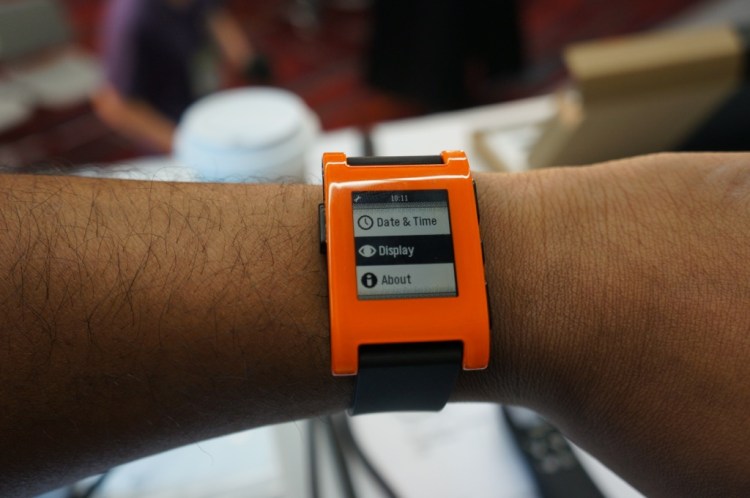Volume Up is a regular column on consumer technology and digital ecosystems by Reticle Research principal analyst Ross Rubin.
This week we saw mighty Microsoft settling for Windows Phone landing on an HTC One, a device that has had Android for five months, and Barnes & Noble lay the final dirt on its tablet hardware ambitions with the announcement of the Samsung Galaxy Tab 4 Nook, which is a mere app and a few widgets away from Samsung’s normal tablets.
Both moves underscore how difficult it is to build platforms even with investing the kind of money that would make Pebble’s record-breaking Kickstarter campaign look like pocket change. The company announced this week that it’s hiring designers behind webOS to help develop its platform as we stand weeks away from the release of the Moto 360 and the widely expected introduction of an Apple watch.
David may have used a stone to defeat Goliath, but can a Pebble also be effective against giants?
The Pebble smartwatch is simple, utilitarian, relatively cheap and humble. It made no grand pronouncements about how it was going to usher in the next wave of computing when it launched last year. But, according to the company, it has always had the mission of being a wearable platform company.
Indeed, Pebble already offers a range of ways to create apps and watchfaces using languages such as JavaScript, Python and C; there’s even a cloud-based development environment. The company may be the only one that has successfully executed finagling an app store within an app on iOS. Pebble apps may not dazzle you with their functionality or appearance, but the hardware is modest and these are early days.
The company recognizes the vast resources that Apple and Google can bring to bear and the close ways it can integrate into their operating systems and other products. And then there’s the question of the webOS legacy. The star-crossed operating system was always praised for its user interface, but was crushed in the market by the same duo that now stands to compete with Pebble. Pebble spins this as an advantage, saying that the new hires have come away with a lot of knowledge to accompany their battle scars.
But there are at least three things in Pebble’s favor. First, unlike with PCs, tablets and phones, many people have more than one watch, a product category that will remain as much about fashion as function. Second, as Dropbox has proven, there’s a place for third parties that play well in multiple operating systems. Pebble points out that, using its tools, it’s possible to pair a Pebble with a Mac or Windows Phone, even though there are no official apps for that.
Pebble has been a pioneer that has held up its proposition pretty well in the face of the first round of watches from Samsung and Google’s other partners. Its ability to survive in the wake of competition with giant ecosystems will depend on whether it can survive any sea changes that Apple may usher in.
Adding further to the webOS legacy intrigue is that that operating system was originally developed to save Palm, a company whose first products had much in common philosophically with the Pebble. But a key difference is that Palm was slow to react to the changes that a revolutionary product brought. Pebble, on the other hand, is at least trying to prepare itself for the coming onslaught.
Ross Rubin is principal analyst at Reticle Research and founder and editor of the crowdfunding product site Backerjack. He also blogs about the tech industry at Techspressive.
VentureBeat's mission is to be a digital town square for technical decision-makers to gain knowledge about transformative enterprise technology and transact. Learn More

